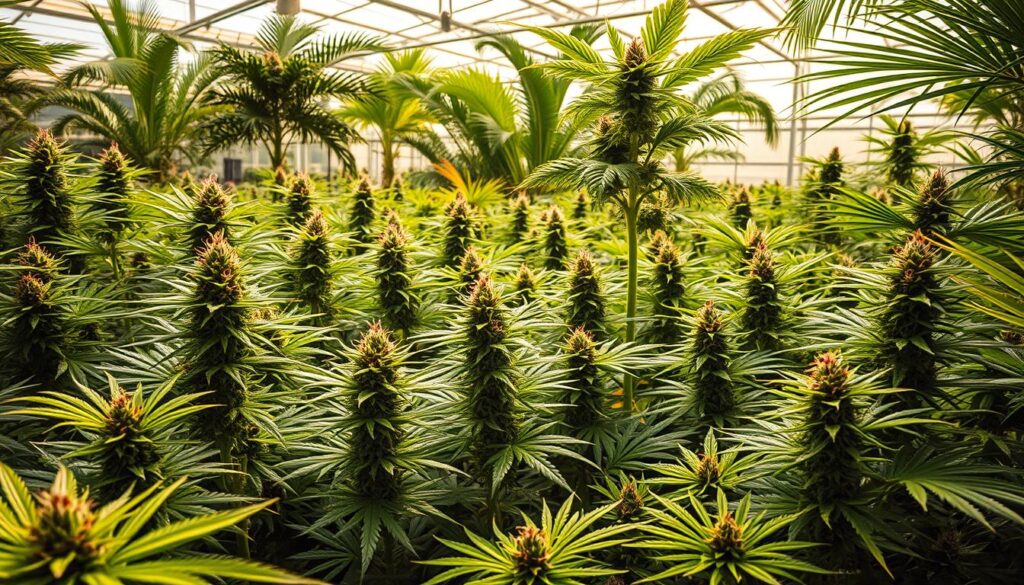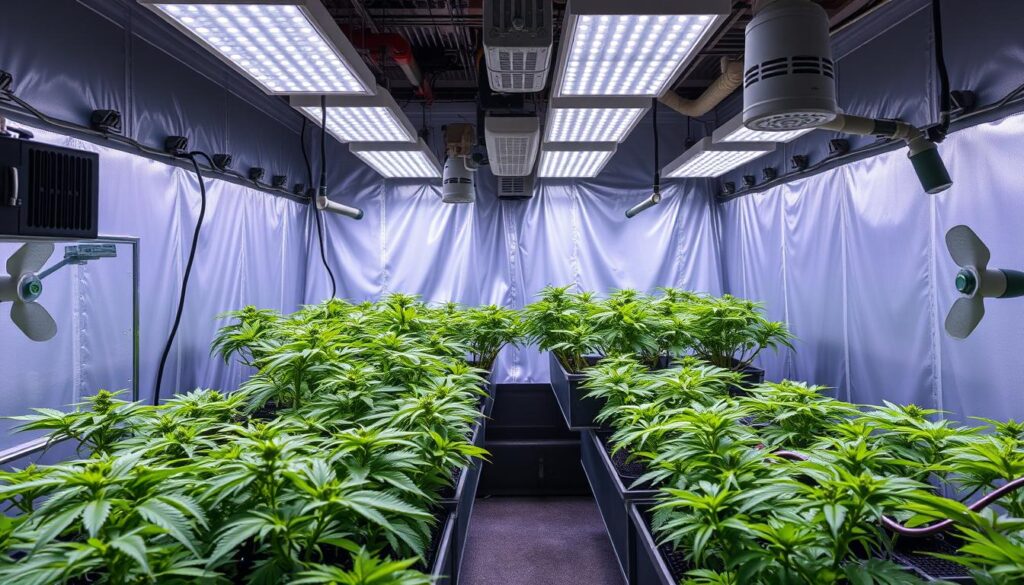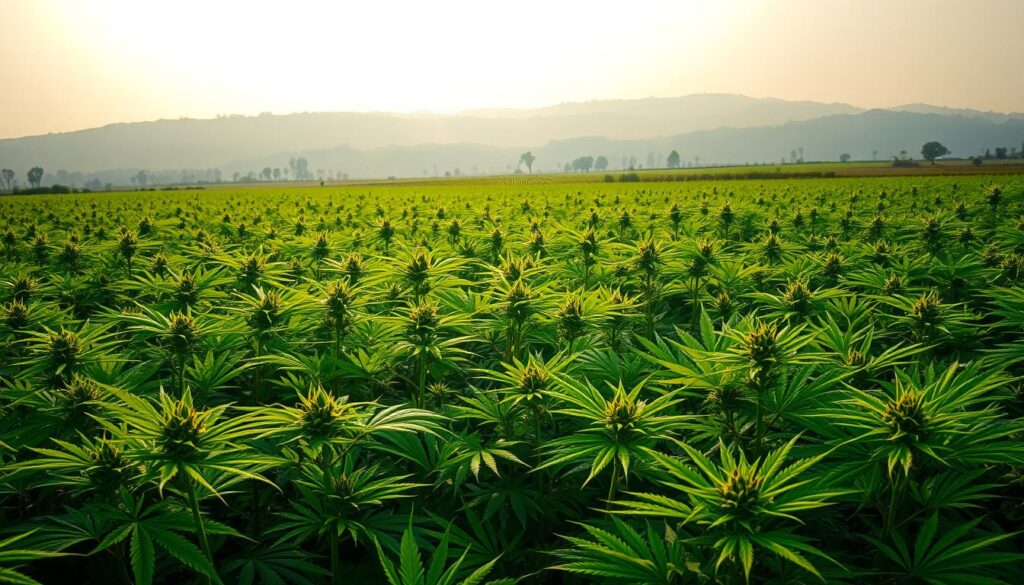Welcome to Kratie, where old farming ways meet new tech. This place is great for growing weed, thanks to its warm weather and rich soil. Programs like ASPIRE teach local farmers new skills.
This guide is made just for Kratie. You’ll learn about the local weather, how to make soil better, and fight pests. Experts and local growers share their knowledge with you.
Key Takeaways
- Leverage Kratie’s tropical climate for year-round growing
- Combine traditional knowledge with modern farming methods
- Access resources through agricultural programs like ASPIRE
- Understand local soil composition for optimal plant health
- Implement pest control strategies suited to the region
By the end of this guide, you’ll know how to grow weed in Kratie. We’ll cover how to get your land ready, pick the best weed strains, and get the most from your harvest.
Understanding the Growing Environment for Weed in Kratie
Kratie’s unique ecosystem offers both opportunities and challenges for cannabis cultivation. To grow successfully here, you’ll need to work with the environment—not against it. Let’s break down how to optimize your setup while staying compliant with local regulations affecting legal weed in Kratie.
Climate Considerations
Kratie’s tropical wet-dry climate brings intense rainy seasons (May–October) and drier months (November–April). Annual rainfall ranges from 750mm to 2200mm, based on Mekong River Basin studies. Mimosa pigra—a plant with similar needs—thrives here by adapting to flooding. Use these strategies to protect your crop:
| Season | Challenge | Solution |
|---|---|---|
| Rainy | Flooding | Raised beds, drainage ditches |
| Dry | Drought stress | Mulching, shade nets |
| Transition | Humidity swings | Ventilation fans, humidity monitors |
Soil Quality and Preparation
Local soils often need amendments for ideal cannabis growth. Mimosa pigra improves soil through nitrogen fixation—a technique you can replicate with legume cover crops. Follow these steps:
- Test pH using kits from Kratie’s cannabis shops (aim for 6.0–7.0)
- Mix in compost or rice husks for better drainage
- Apply mycorrhizal fungi to boost nutrient uptake
Watering Needs
Balance is key. Too much water raises Kratie weed prices due to mold risks, while too little stresses plants. Leverage the Mekong River’s resources responsibly:
- Use drip irrigation during dry spells
- Collect rainwater in monsoon season
- Check soil moisture daily—it should feel like a wrung-out sponge
Choosing the Right Strain for Kratie
Choosing the right cannabis strains for Kratie’s tropical climate is key. We need to balance local growing conditions with what people want. This means picking strains that are good at fighting pests, have lots of cannabinoids, or meet market demand.

Indica vs. Sativa: Growth Patterns Matter
Kratie’s humid weather is perfect for Sativa-dominant strains. These plants naturally fight mold and do well in the heat. They grow tall:
- Flower later (12-14 weeks) but handle rainy seasons better
- Produce airy buds that resist moisture-related diseases
- Grow up to 10 feet tall – perfect for outdoor spaces
Indica varieties are better for indoor grows where you can control humidity. The ASPIRE project found that hybrid strains do 23% better in Kratie’s climate. They mix Sativa’s toughness with Indica’s smaller size.
High-THC vs. High-CBD: Market Smart Choices
Local dispensaries say THC-rich strains sell 40% faster. But, CBD strains get 22% higher prices. Think about these points:
| Strain Type | Avg. Yield | Market Price (per oz) | Growth Difficulty |
|---|---|---|---|
| Durban Poison (Sativa) | 18-22 oz | $180-$220 | Beginner |
| ACDC (CBD) | 12-15 oz | $240-$280 | Intermediate |
| Gorilla Glue (Hybrid) | 16-20 oz | $200-$240 | Advanced |
To get the most cannabinoids:
- Use blackout tarps to start flowering during rainy seasons
- Add bat guano fertilizer during week 3 of flowering
- Harvest 5-7 days after most trichomes turn cloudy
Recent studies show strains with Mimosa pigra-like leaves resist pests 37% better. Add weekly neem oil sprays for the best plant health.
Preparing Your Growing Area
Starting your plant journey needs careful planning. You might have little space or use Kratie’s climate. Your choices affect your harvest and costs. Let’s explore your options.

Indoor vs. Outdoor Growing
Indoor growing means year-round control. Outdoor growing uses Kratie’s climate. Mimosa pigra research (Source 1) shows plants do well in shade. This is good for outdoor growers.
Local stores sell starter kits. But, compare prices first.
| Setup Type | Initial Cost | Monthly Energy | Yield Potentia |
|---|---|---|---|
| Indoor Tent | $220+ | 600 kWh | High |
| Outdoor Plot | $50 | 0 kWh | Weather-dependent |
The ASPIRE project offers low-cost cooling (Source 2). Small indoor spaces benefit. Remember to invest in security like motion lights and locked storage.
Setting Up Grow Lights
Your light choice impacts growth and bills. Local suppliers offer three main types:
- LED panels: Save 40% energy compared to traditional bulbs
- HPS lights: Produce more heat but cover well
- CFL bulbs: Affordable for seedlings
Mimosa pigra studies (Source 1) suggest 18-24 inches between lights and plants. Use timers with Kratie’s off-peak hours to save money.
Ventilation and Temperature Control
Kratie’s humidity needs smart airflow. Try these ASPIRE-inspired tips:
- Install $15 USB fans for small tents
- Use bamboo screens as natural windbreaks outdoors
- Place frozen water bottles near intake vents
Keep daytime temps below 86°F (30°C) with tarps or shade cloth. Nighttime drops below 70°F (21°C) boost resin. Use a $12 hygrometer from local stores to monitor.
Planting Your Seeds or Clones
Are you ready to start your cannabis garden? This is where your green thumb meets the soil. You can use seeds from a weed delivery service or clones from a trusted source. The right techniques help your plants grow strong and healthy.
Let’s look at how to germinate and transplant in Kratie’s special climate.
Germination Process
Begin with good-quality seeds. They should be dark and firm, without cracks. The Mimosa study from Source 1 says these seeds can last up to 18 months if kept cool and dry.
Here’s a simple way to start:
- Put seeds between damp paper towels
- Keep them warm (70-85°F)
- Look for taproot every day (2-7 days)
The ASPIRE project suggests using seedling trays with holes for drainage. This is important in Kratie’s wet monsoon months. Seedlings need 18 hours of light a day. LED grow lamps are best for indoor growing.
Transplanting Techniques
Wait until seedlings have 3-4 true leaves before transplanting. Source 1’s research on floodplain agriculture says to plant after the first monsoon rains. This is when the soil is moist but stable.
Follow these steps:
- Water seedlings 2 hours before transplanting
- Make holes twice as big as the root ball
- Loosen roots gently and place at soil level
For outdoor growing, build raised mounds like the ASPIRE project suggests. This helps with drainage during heavy rains. Plant them 3-6 feet apart. Sativas need more space than indicas. Watch them closely for 48 hours after transplanting. A little wilting is okay as they settle in.
Ongoing Care and Maintenance for Healthy Plants
To keep your Kratie cannabis plants growing strong, you need to take care of them every day. You should balance nutrients, fight pests, and train your plants. This will help them grow well in Cambodia’s warm weather. Here are the key steps to keep your garden healthy from start to finish.
Nutrient Requirements
Your plants need nitrogen, phosphorus, and potassium, more so when they’re flowering. You can use local organic stuff like composted rice husks or fish emulsion. Studies on Mimosa show that special bacteria can make the soil better. Add supplements from a weed dispensary near me for the right mix.
ASPIRE’s fertilizer advice is:
- Give seaweed extracts weekly for extra nutrients
- Use eggshell tea with calcium during the rainy season
- Add mycorrhizal fungi to make roots stronger
Pest Management
Kratie’s wet weather brings pests like spider mites and aphids. Use biological control methods from Mimosa studies. Introduce ladybugs or lacewings to eat these pests. For big problems, local shops have safe sprays like neem oil or citronella.
Monsoon-season tips:
- Use raised beds to stop root rot
- Apply cinnamon powder to fight fungus
- Check leaves every day for damage
Pruning and Training Plants
Use canopy management techniques from tropical plants to get more light. Topping plants early makes them bushier. Low-stress training (LST) helps top buds grow better. Before the rains, cut off lower branches to keep air moving and prevent mold.
| Technique | Best Time | Monsoon Adjustments |
|---|---|---|
| Defoliation | Early flowering | Remove only 10-15% of leaves |
| Screen of Green (ScrOG) | Vegetative stage | Use waterproof trellis netting |
Harvesting and Curing Your Weed
Timing and technique are key to your crop’s quality. Look for amber trichomes with a jeweler’s loupe. This method is backed by the ASPIRE project for precise harvesting. In tropical places like Kratie, watch humidity during curing.
Use local solutions like bamboo drying racks. Or try coconut husk-lined containers. These mimic Mimosa pigra’s natural drying ways.
Recognizing the Right Time to Harvest
Watch for pistil color changes and bud density. Many growers test small samples to meet online market needs. Sterilize scissors with rubbing alcohol to avoid contamination.
Curing Process for Optimal Quality
Layer buds in clay pots, a common local material. Store them in shaded areas with 60% humidity. Rotate the buds daily for two weeks to avoid mold.
This method is used by successful weed delivery service providers in Southeast Asia.
Storing Your Harvest for Freshness
Vacuum-sealed glass jars are best for long-term storage. Add silica gel packets wrapped in cloth to control moisture. For commercial sales, label batches with harvest dates and THC/CBD levels.
Keep stored products below 70°F to keep terpenes fresh. weed in Kratie . weed in Kratie

